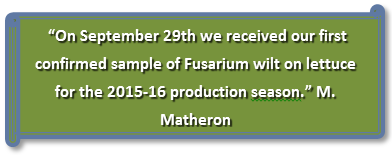
On September 29th we received our first confirmed sample of Fusarium wilt on lettuce
for the 2015-16 production season. Since the first discovery of this disease in
Arizona during the 2001-02 growing season, Fusarium wilt has been found yearly in
some lettuce fields, usually from October through early January. The initial visual
indication of the disease is yellowing of one or more older leaves, followed by
leaf wilting and eventually plant death. The external root surface is unaffected;
however, a brown to black necrosis of the internal taproot and crown tissue will
be apparent. Disease incidence can range from a few plants up to large areas or
zones of infected plants within a field. Plants can become infected and display
symptoms at any age, ranging from very young plants just after thinning to those
ready for harvest. The symptoms of Fusarium wilt resemble two other lettuce disorders,
ammonia toxicity and the early stages of lettuce drop. To confirm disease identity,
it is necessary to bring plant samples to me at the Yuma Agricultural Center for
analysis. Confirmation of disease identity is achieved by isolation and identification
of the causal fungus, Fusarium oxysporum, f. sp. lactucae, from symptomatic root
tissue. Disease incidence and severity are strongly affected by planting date and
the type of lettuce grown. The main determinant of disease severity with respect
to planting date is soil temperature. Research data demonstrate that lettuce planted
in early September can result in high levels of Fusarium wilt, whereas plantings
in the same naturally-infested field started in mid-October or early December sustain
moderately low and trace levels of disease, respectively. Of many crisphead and
romaine cultivars tested, crisphead cultivars generally are significantly more susceptible
to Fusarium wilt than romaine lettuce. There are also significant differences in
susceptibility among romaine cultivars. The lettuce Fusarium wilt pathogen can survive
in soil for many years, so minimizing the spread of infested soil both within and
especially between fields is of paramount importance. Two field trials have been
established in early September in growers’ fields to evaluate some current lettuce
varieties, experimental lines, fungicides and biofungicides for potential efficacy
in managing Fusarium wilt of lettuce. Examination of these trials will be part of
the activities during the upcoming International Symposium on Fusarium Wilt of Lettuce
to be held in Yuma on November 12-13, 2015. Go to
http://yceda.cals.arizona.edu for meeting information. Also, see a new publication
entitled
“Biology and Management of Fusarium Wilt of
Lettuce".

Fusarium Mycelium
Click picture to listen to Mike's update

To contact Mike Matheron go to: matheron@ag.arizona.edu.




